Phase Equilibrium Diagram for Electric Arc Furnace Slag Optimization in High Alloyed Chromium Stainless Steelmaking
Abstract
1. Introduction
2. EAF Slag Characteristics at High Cr Steel Melts
3. Modelling
3.1. FactSage and Database
- (i)
- Liquid Slag: CaO-MgO-SiO2-Al2O3-FeO-Fe2O3-MnO-Mn2O3-CrO-Cr2O3-S-P-F-etc.
- (ii)
- Spinel phase: (Mg,Fe,Mn,..)[Cr,Al,Fe,..]2O4
- (iii)
- Monoxide phase: MgO-CaO-FeO-MnO rocksalt phase with a small solubility of Al2O3, Cr2O3, etc.
- (iv)
- Dicalcium silicate phase: Ca2SiO4-rich solution phase, (Ca,Mg,Fe,Mn)2SiO4 solid solution
- (v)
- Corundum phase: (Cr,Al,Fe)2O3
- (vi)
- Olivine phase: (Mg,Mn,Fe,Ca)2SiO4 solid solution
3.2. Modelling of Cr-Bearing Slags
4. Results: Application to Slag Analysis Data from Stainless Steelmaking
5. Discussion
6. Conclusions
Author Contributions
Funding
Acknowledgments
Conflicts of Interest
References
- Pretorius, E.B.; Nunnington, R.C. Stainless steel slag fundamentals—From furnace to tundish. Ironmak. Steelmak. 2002, 29, 133–139. [Google Scholar] [CrossRef]
- Guo, M.; Durinck, D.; Jones, P.T.; Heylen, G.; Hendrickx, R.; Baeten, R.; Blanpain, B.; Wollants, P. EAF Stainless Steel Refining-Part I: Observational Study on Chromium Recovery in an Eccentric Bottom Tapping Furnace and a Spout Tapping Furnace. Steel Res. Int. 2007, 78, 117–124. [Google Scholar] [CrossRef]
- Bažan, J.; Socha, L.; Kurka, V.; Jonšta, P.; Sušovský, M. Increase of chromium yield by slag reduction during production of chromium steels. IOP Conf. Ser. Mater. Sci. Eng. 2017, 179, 1–7. [Google Scholar] [CrossRef]
- Mees, H.; Senk, D. Reduzierung von Chromanteilen in E-Ofen-Schlacken durch Steigerung der Legierungsmitteleffizienz bei der Erzeugung von hochchromhaltigen Schmelzen (Decrease of Chromium content in EAF slags by increased efficiency of alloys at the production of high Chromium melts). In Mineralische Nebenprodukte und Abfälle 4-Aschen, Schlacken, Stäube und Baurestmassen; Thomé-Kozmiensky, K.J., Thiel, S., Thomé-Kozmiensky, E., Friedrich, B., Pretz, T., Quicker, P., Senk, D.G., Wotruba, H., Eds.; TK Verlag: Neuruppin, Germany, 2017; ISBN 978-3-944310-35-0. [Google Scholar]
- Kühn, M.; Mudersbach, D.; Baena Liberato, J.M.; De Angelis, V.; Capodilupo, D.; De Fries, U. Chrome Immobilization in EAF Slags from High-Alloy Steelmaking: Development of a Slag Treatment Process; EU report no. 22077-EN; Directorate-General for Research and Innovation: Brussels, Belgium, 2006; ISBN 92-79-02077-3. [Google Scholar]
- Kühn, M.; Mudersbach, D. Treatment of liquid EAF-slag from stainless steelmaking to produce environmental friendly construction materials. In Proceedings of the 2nd International Conference on Process Development in Iron and Steelmaking (Scanmet II), Lulea, Sweden, 6–9 June 2004; Volume 2, pp. 369–377. [Google Scholar]
- Zhao, Q.; Liu, C.; Cao, L.; Zheng, X.; Jian, M. Effect of Lime on Stability of Chromium in Stainless Steel Slag. Minerals 2018, 8, 424–434. [Google Scholar] [CrossRef]
- Albertsson, G.; Teng, L.; Björkman, B.; Seetharaman, S.; Engström, F. Effect of Low Oxygen Partial Pressure on the Chromium Partition in CaO–MgO–SiO2–Cr2O3–Al2O3 Synthetic Slag at Elevated Temperatures. Steel Res. Int. 2013, 84, 670–679. [Google Scholar] [CrossRef]
- Zeng, Q.; Li, J.; Mou, Q.; Zhu, H.; Xue, Z. Effect of FeO on Spinel Crystallization and Chromium Stability in Stainless Steel-Making Slag. J. Miner. Met. Mater. Soc. 2019, 71, 2331–2337. [Google Scholar] [CrossRef]
- Sano, N. Reduction of Chromium Oxide in stainless steel slags. In Proceedings of the 10th International Ferroalloys Congress, Cape Town, Africa, 1–4 February 2004; pp. 670–677, ISBN 0-9584663-5-1. [Google Scholar]
- Pontikes, Y.; Jones, P.T.; Geysen, D.; Blanpain, B. Options to prevent dicalcium silicate-driven disintegration of stainless steel slags. Arch. Metall. Mater. 2010, 55, 1167–1172. [Google Scholar] [CrossRef]
- Kirschen, M.; Hanna, A.; Zettl, K.-M. Improvement of EAF process and refractory consumption by advanced slag modelling. Iron Steel Technol. 2016, 13, 52–59. [Google Scholar]
- Bale, C.W.; Bélisle, E.; Chartrand, P.; Decterov, S.A.; Eriksson, G.; Gheribi, A.E.; Hack, K.; Jung, I.-H.; Kang, Y.-B.; Melançon, J.; et al. FactSage thermochemical software and databases–2010–2016. Calphad 2016, 54, 35–53. [Google Scholar] [CrossRef]
- Mostafee, S. A Study of EAF High-Chromium Stainless Steelmaking Slags Characteristics and Foamability. Ph.D. Thesis, Royal Institute of Technology, Stockholm, Sweden, 2011; p. 66. [Google Scholar]
- Morita, K.; Tsukiashi, K.; Kimura, M.; Sano, N. Activity of Chromium Oxide in CaO-SiO2 based slags at 1873 K. Steel Res. Int. 2005, 76, 279–283. [Google Scholar] [CrossRef]
- Dong, P.; Wang, X.; Seetharaman, S. Thermodynamic activity of Chromium Oxide in CaO-SiO2-MgO-Al2O3-CrOx melts. Steel Res. Int. 2009, 80, 202–208. [Google Scholar]
- Li, J.; Zeng, Q.; Mou, Q.; Yu, Y. Effect of Basicity on Precipitation of Spinel Crystals in a CaO-SiO2-MgO-Cr2O3-FeO System. High Temp. Mater. Proc. 2019, 38, 867–872. [Google Scholar] [CrossRef]
- Arnout, S.; Verhaeghe, F.; Blanpain, B.; Wollants, P. A thermodynamic model of the EAF process for stainless steel. In Proceedings of the European Metallurgical Conference, Dresden, Germany, 18–21 September 2005; Volume 3, pp. 1325–1337. [Google Scholar]
- Jung, I.-H.; Decterov, S.; Pelton, A.D. Thermodynamic modelling of MgO-Al2O3-CrO-Cr2O3 systems. J. Am. Ceram. Soc. 2005, 88, 1921–1928. [Google Scholar] [CrossRef]
- Arnout, S.; Guo, M.; Durinck, D.; Jones, P.T.; Blanpain, B.; Wollants, P. Phase relations in stainless steel slags. In Proceedings of the European Metallurgical Conference, Düsseldorf, Germany, 11–14 June 2007; pp. 1931–1946. [Google Scholar]
- Jung, I.-H. Overview of the applications of thermodynamic database to steelmaking process. Calphad 2010, 34, 332–362. [Google Scholar] [CrossRef]
- Durinck, D.; Jones, P.T.; Guo, M.; Verhaeghe, F.; Heylen, G.; Hendrickx, R.; Baeten, R.; Blanpain, B.; Wollants, P. EAF Stainless Steel Refining-Part II: Microstructural Slag Evolution and its Implications for Slag Foaming and Chromium Recovery. Steel Res. Int. 2007, 78, 125–135. [Google Scholar] [CrossRef]
- Arnout, S.; Guo, M.; Jung, I.-H.; Blanpain, B.; Wollants, P. Experimental determination of CaO-CrO-Cr2O3-MgO-SiO2 and thermodynamic modeling of the CrO-Cr2O3-MgO-SiO2 system. J. Am. Ceram. Soc. 2009, 92, 1831–1839. [Google Scholar] [CrossRef]
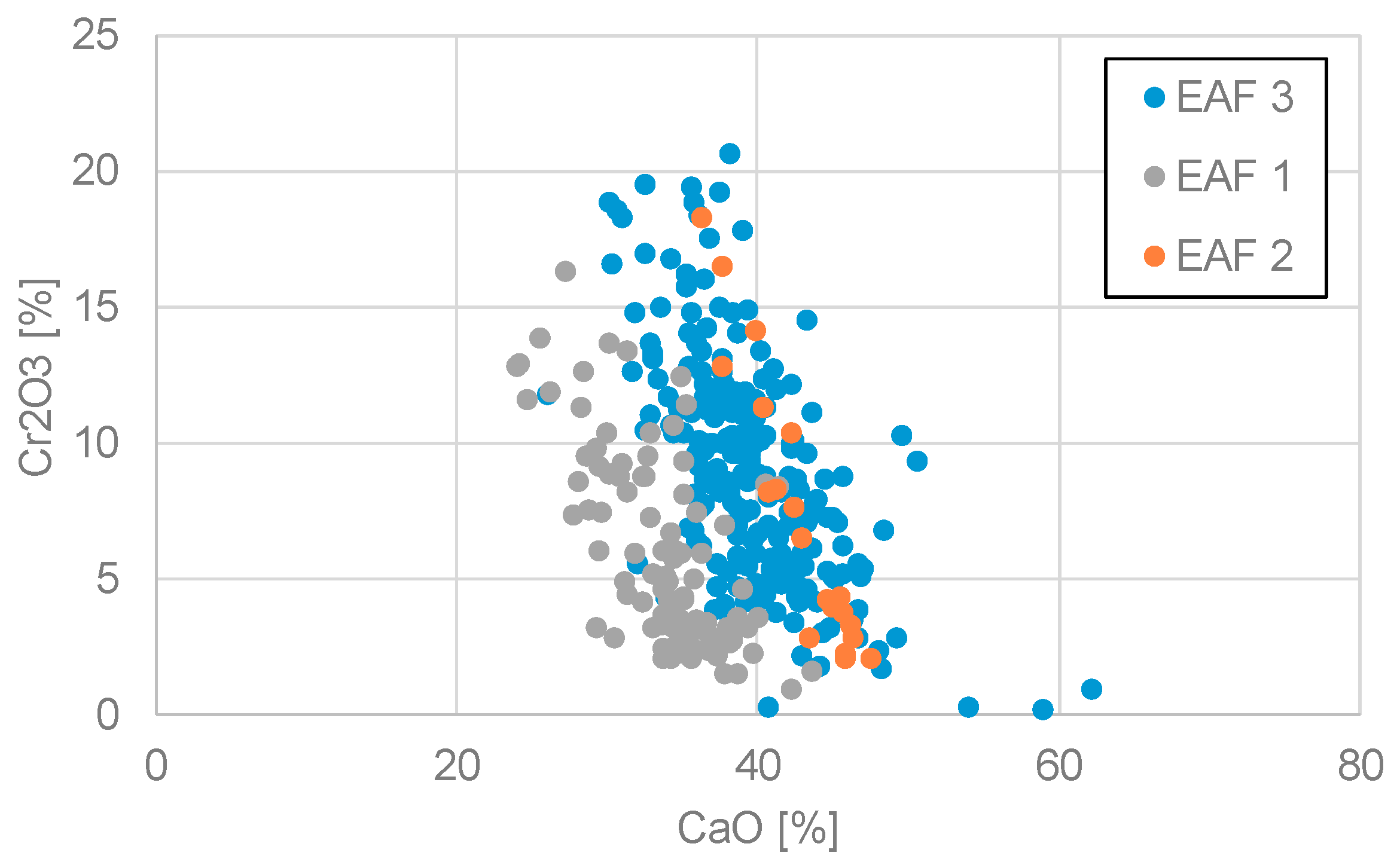
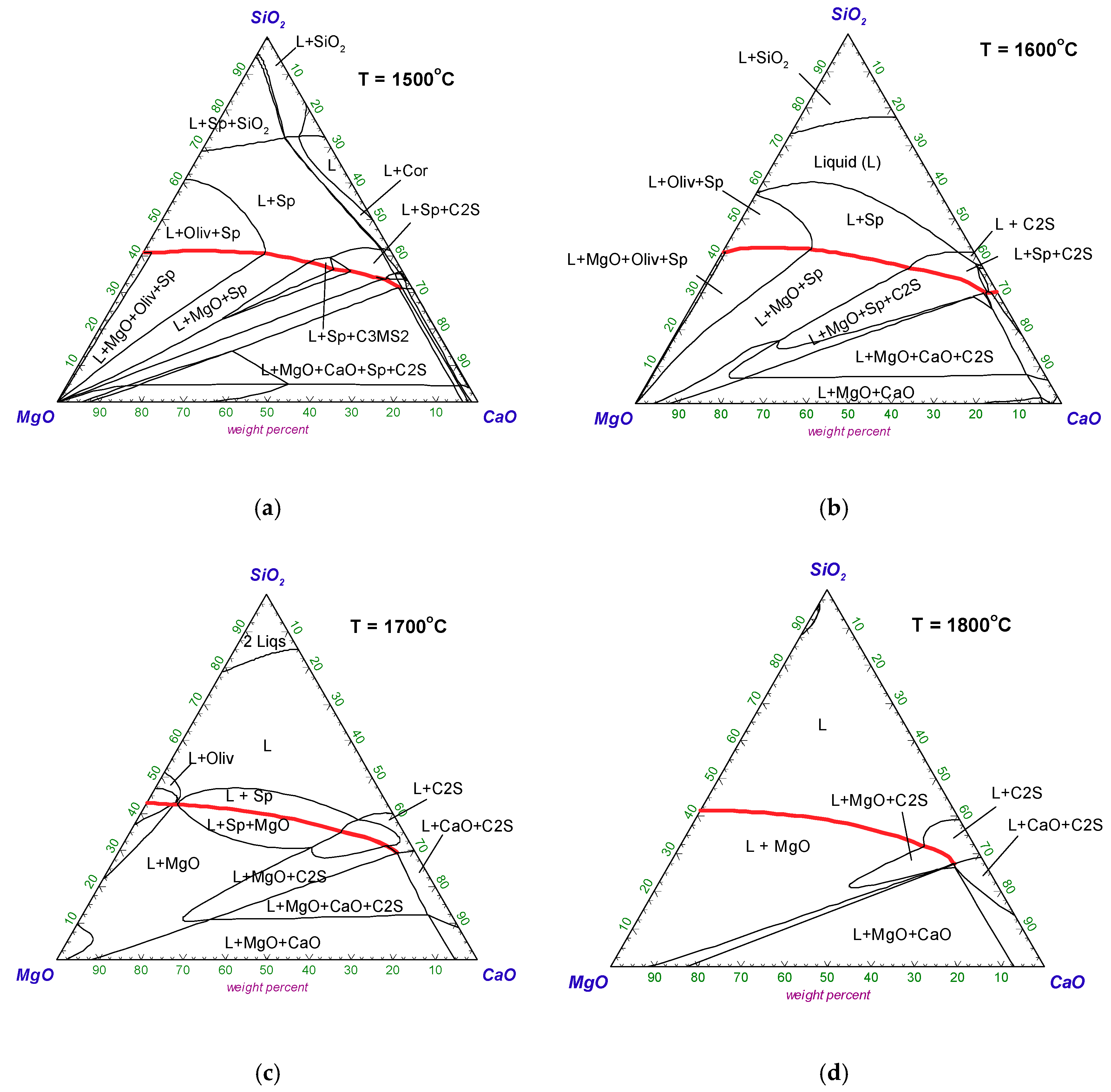
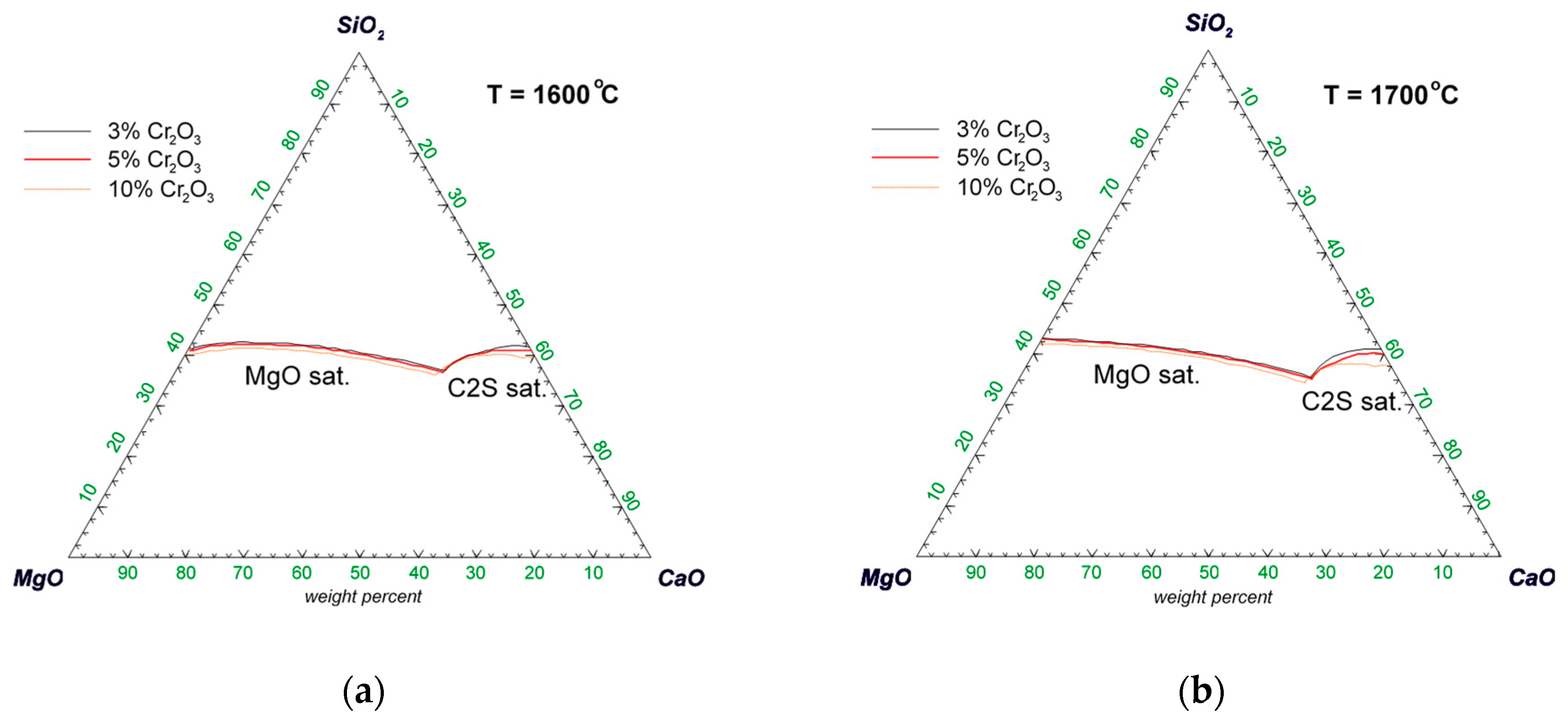
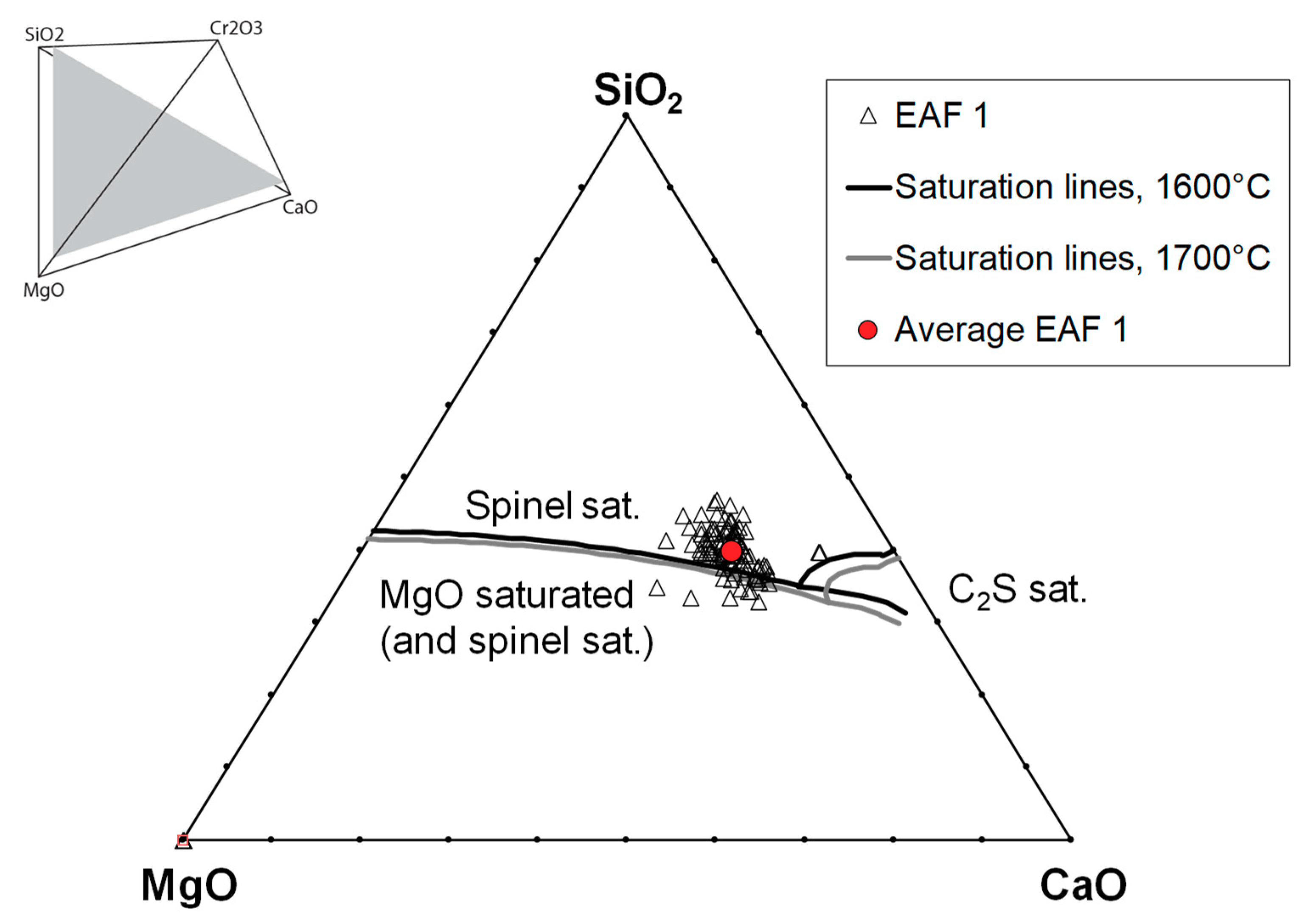
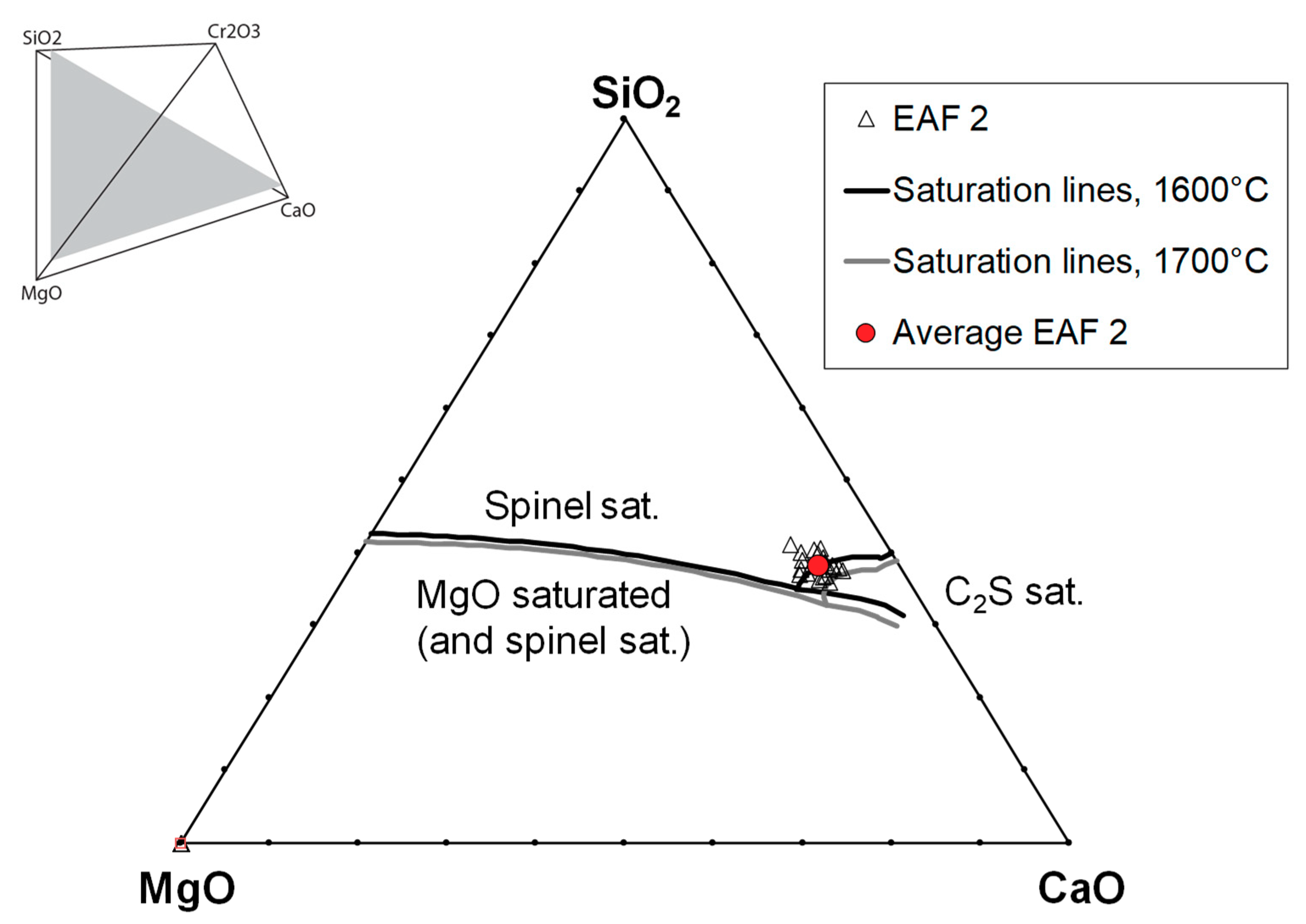
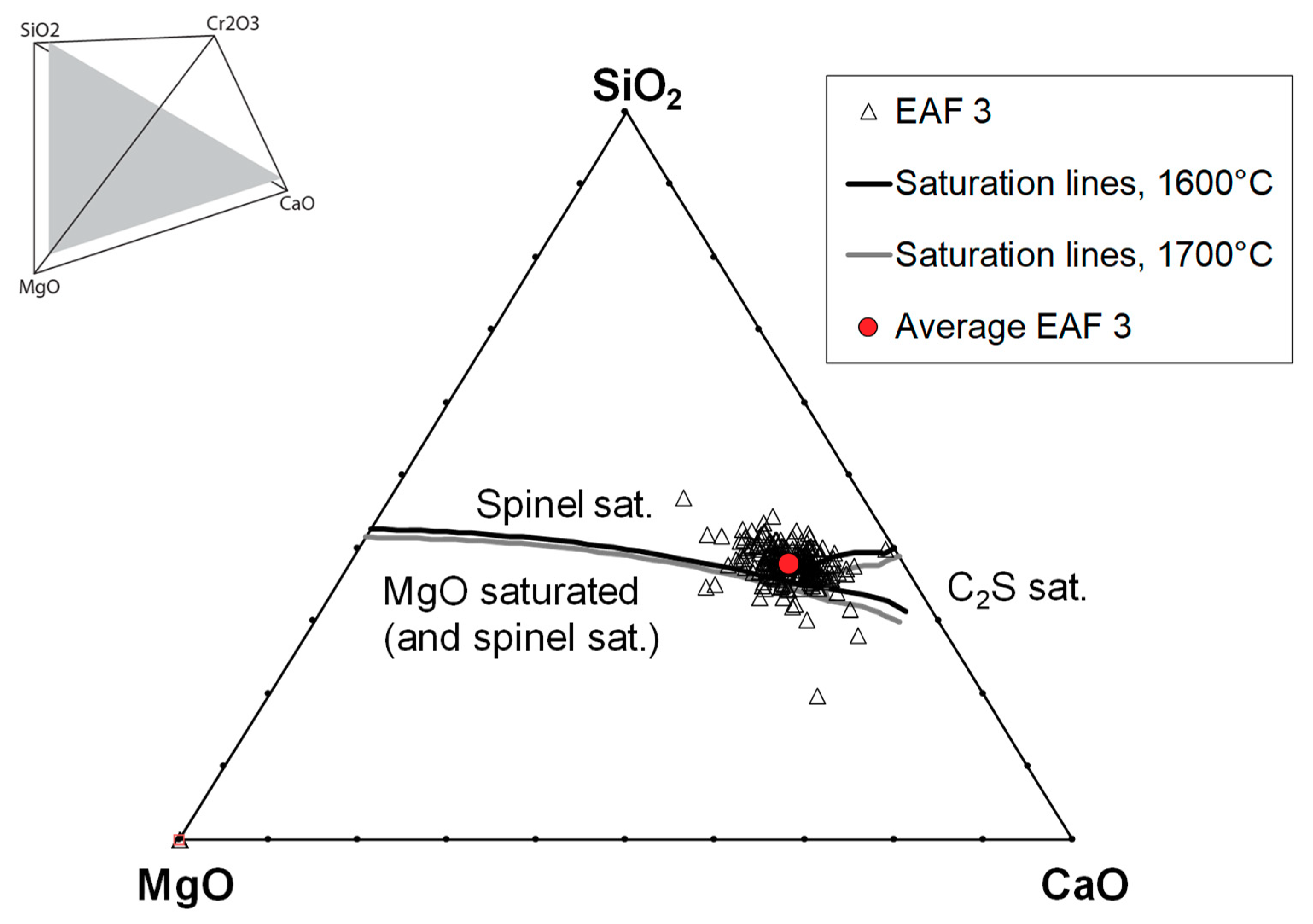
| EAF | MgO | CaO | FeO | Al2O3 | SiO2 | MnO | Cr2O3 | TiO2 | Total | Basicity | |
|---|---|---|---|---|---|---|---|---|---|---|---|
| 1 | 14.9 | 33.8 | 1.47 | 6.01 | 32.5 | 3.55 | 5.94 | 1.73 | 100.0 | 1.04 1 | 1.26 2 |
| 2 | 7.4 | 43.0 | n.a. | 4.34 | 31.4 | n.a. | 7.19 | 1.30 | 94.7 | 1.37 1 | 1.41 2 |
| 3 | 10.2 | 39.3 | 1.47 | 4.65 | 30.4 | 2.78 | 9.05 | 1.33 | 99.2 | 1.31 1 | 1.41 2 |
| 4 [5] 3 | 3.08 | 44.4 | 2.29 | 5.64 | 28.3 | 2.69 | 10.13 | n.a. | 96.5 | 1.57 1 | 1.40 2 |
| 5 [14] | 7.0 | 47.4 | 1.2 | 4.6 | 31.7 | 2.3 | 4.7 | 0.8 | 99.7 | 1.51 1 | 1.50 2 |
© 2020 by the authors. Licensee MDPI, Basel, Switzerland. This article is an open access article distributed under the terms and conditions of the Creative Commons Attribution (CC BY) license (http://creativecommons.org/licenses/by/4.0/).
Share and Cite
Kirschen, M.; Jung, I.-H.; Hackl, G. Phase Equilibrium Diagram for Electric Arc Furnace Slag Optimization in High Alloyed Chromium Stainless Steelmaking. Metals 2020, 10, 826. https://doi.org/10.3390/met10060826
Kirschen M, Jung I-H, Hackl G. Phase Equilibrium Diagram for Electric Arc Furnace Slag Optimization in High Alloyed Chromium Stainless Steelmaking. Metals. 2020; 10(6):826. https://doi.org/10.3390/met10060826
Chicago/Turabian StyleKirschen, Marcus, In-Ho Jung, and Gernot Hackl. 2020. "Phase Equilibrium Diagram for Electric Arc Furnace Slag Optimization in High Alloyed Chromium Stainless Steelmaking" Metals 10, no. 6: 826. https://doi.org/10.3390/met10060826
APA StyleKirschen, M., Jung, I.-H., & Hackl, G. (2020). Phase Equilibrium Diagram for Electric Arc Furnace Slag Optimization in High Alloyed Chromium Stainless Steelmaking. Metals, 10(6), 826. https://doi.org/10.3390/met10060826





